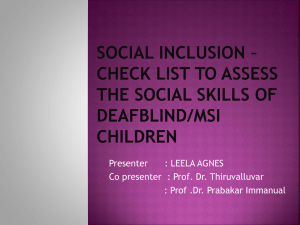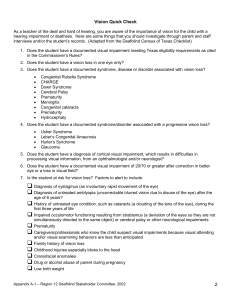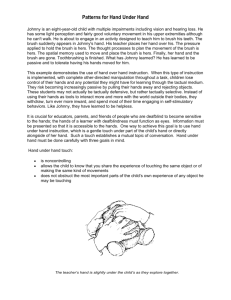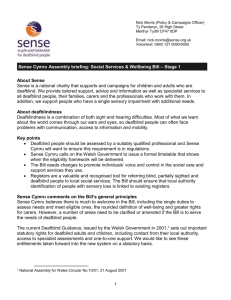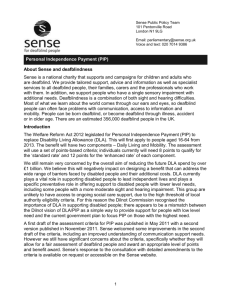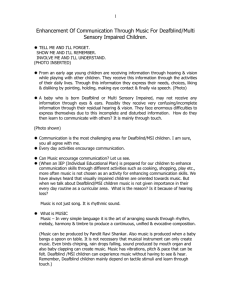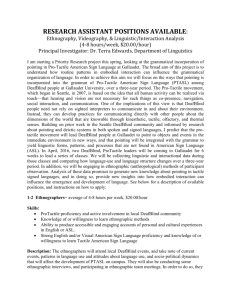Fill in the Gaps > Too many older people who are deafblind miss out
advertisement
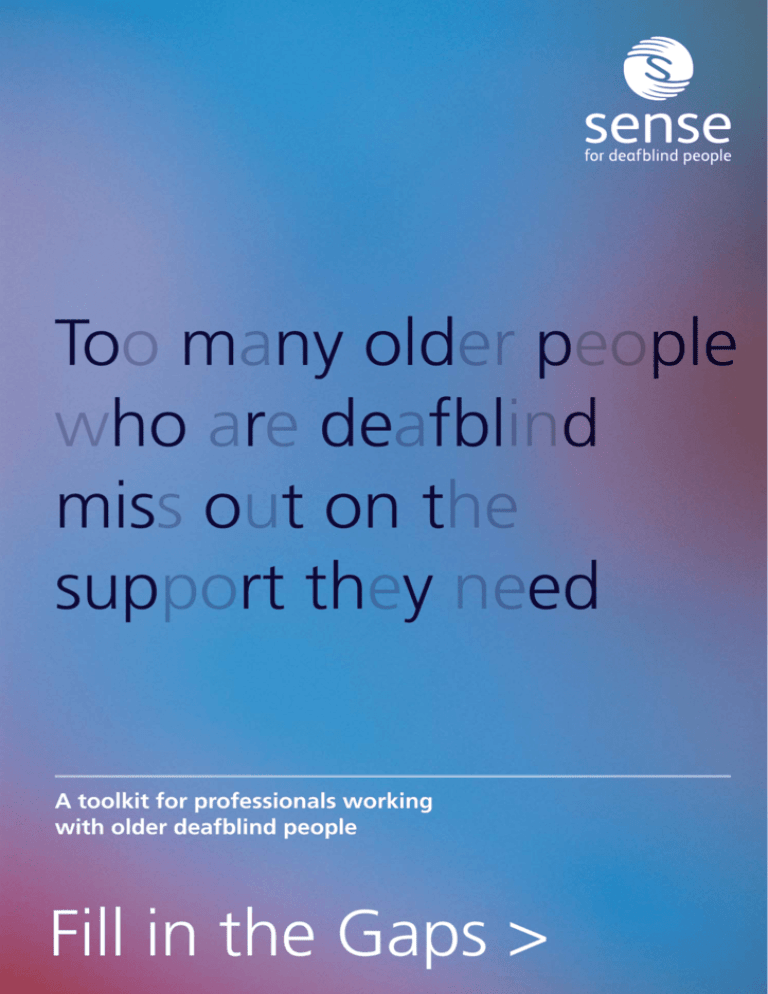
Too many older people who are deafblind miss out on the support they need A toolkit for professionals working with older deafblind people Fill in the Gaps > This booklet offers information and advice for those working with older deafblind people. It explains what deafblindness is and how it affects people. It sets out the legal responsibilities that social services have and explains how deafblind people can be supported and helped. Increasing numbers of older people are developing hearing and vision problems. Some older people have substantial hearing and vision difficulties – known as deafblindness. Often this hearing and vision loss comes on very gradually. Older people themselves, and others around them, may not recognise or understand what is happening. Because of this combined hearing and vision loss, they may have problems with communicating, getting around and accessing information. This can cause difficulties with many everyday activities and can make them feel excluded from society. But it doesn’t have to be like this. If the right services and opportunities are available, older deafblind people can live independently and make choices about how they wish to live. If appropriate services are provided at the right time, the need for greater health and social care provision at a later stage can be reduced. Local authorities have statutory responsibilities towards older people with combined hearing and vision loss – arising from the guidance ‘Social Care for Deafblind Children and Adults’ LAC(DH) (2009)6. They are required to provide specialist assessments, appropriate information and services designed to meet the needs of deafblind people. We will refer to the Deafblind Guidance throughout this booklet. In many cases, older deafblind people are seen by a social work team for older people – rather than a team which specialises in sensory impairment. This booklet explains how you can help to make sure that older deafblind people get the support they are entitled to. 3 Fill in the Gaps > 1 > Deafblindness and older people 3 3 4 5 What is deafblindness? How it affects older people Talking about sensory loss How many older people are affected? 2 > Legal requirements 7 8 10 11 13 What does the Deafblind Guidance say? The Single Assessment Process Fair Access to Care Services Recognising deafblindness The National Service Framework 3 > Working with older deafblind people 15How can your team work effectively with older deafblind people? 16 Indicators of hearing and vision loss 17 Communicating effectively – face to face 18 Communicating effectively – at a distance 21 Checklist 4 > Resources 23 Useful organisations 24 References 24 Web based resources 1 2 3 4 1 1 > Deafblindness and older people The term ‘deafblind’ describes people of all ages who have a combined hearing and vision impairment. These individuals may be deaf or hard of hearing as well as blind or partially sighted. They do not have to be completely deaf and blind. In fact, most deafblind people have some useful hearing or vision. Deafblindness is a unique disability unique 2 What is deafblindness? deaf deafblind Definitions of deafblindness tend not to focus on the degree of deafness or blindness a person has, but rather on the effect of the combined loss on everyday life – how it affects their ability to communicate, to get around and to access all kinds of information. Deafblindness is not just a deaf person who cannot see or a blind person who cannot hear. The two impairments impact on each other and multiply the total effect. One deafblind person describes it like this: blind “If you think of deafness as the colour yellow and blindness as the colour blue, when you mix the two together you don’t get yellow-blue but a completely different colour – green.” How it affects older people Deafblindness affects different people in different ways. When communication is limited, people become socially and emotionally isolated. When people can’t get around by themselves it affects their confidence, independence and daily living skills. Without access to information, people can’t make informed decisions and this leads to further loss of independence. These are common experiences for older deafblind people. Older People’s social work teams can do a great deal to help older deafblind people. See page 15 for information on how to make this happen. A combination of visual and hearing impairment will multiply the difficulties an individual faces. For example… • If you are deaf or hard of hearing and can’t hear what someone is saying, you watch their lips and facial expressions for extra clues. But if you also become blind or partially sighted, how will you understand what is being said? • If you are a blind or partially sighted person who is used to travelling independently, you depend on your hearing. But if you become deaf or hard of hearing and can’t hear or see the traffic, how will you know when it’s safe to cross the road? • If you can no longer easily see or hear the television, listen to the radio, read your letters, use the phone or engage in conversation you become isolated from people, events and society. This sensory deprivation can lead to extreme levels of boredom, stress, depression and withdrawal. 3 1 > Deafblindness and older people Don’t miss an opportunity If we take the view that loss of sight and hearing are a normal, acceptable part of ageing, we miss the opportunity to help people make best use of their remaining vision and hearing. Talking about sensory loss Many older people with a hearing and vision loss don’t think of themselves as deafblind. They may think that sensory loss is just one more effect of old age along with mobility problems, memory loss, illness or depression – and it often is. But that doesn’t mean we can’t do anything about it. Their hearing and vision loss may have crept up on them slowly so they only gradually realise that something is wrong. They may see some things, but not others. They may hear in some situations, but not others. They may use phrases such as: “I don’t hear too well” or “I’m having problems with my eyes”. And yet the everyday difficulties they describe are not just to do with ageing but are the typical effects of deafblindness. Professionals are likely to use terms such as deafblind or dual sensory loss. The Deafblind Guidance uses these interchangeably to acknowledge that the combined loss of hearing and vision is significant for anyone, even if he or she still has some useful hearing and vision. Even if a person doesn’t use the term deafblind about themselves, we need to recognise the effects of deafblindness and offer support and services to meet those needs. Be aware of the language a person uses about themselves and adapt your own to reflect what they are comfortable with. 4 How many older people are affected? Sense commissioned independent, expert research on the numbers of deafblind people in 2010. The Centre for Disability Research report found that the deafblind population has been significantly underestimated. 62% of the deafblind population is aged over 70 and the numbers will increase dramatically over the next 20 years as a result of the ageing population. 356,000 deafblind people in the UK • • Of which, 220,000 • people over the age of 70 have significant combined visual impairment and hearing loss Future explosion in numbers by 2030 569,000 deafblind people in the UK, a 60% increase • • Of which, 418,000 • will be people over the age of 70 have significant combined visual impairment and hearing loss (Sense/CeDR, 2010) Older people • with vision and hearing loss from minority communities are poorly represented in statistics but it is likely that the incidence is similar to that of white British communities. These figures show how common dual sensory loss is among older people. You are probably already in contact with some older people with dual sensory loss. Read on to find out how you can make your services accessible to them and promote independence and choice. You are probably already in contact with some older people with dual sensory loss 5 2 > Legal requirements All Social Services teams need to understand how to respond to the needs of deafblind people. This chapter sets out how the deafblind guidance relates to other guidance you will be working with. A framework for deafblind support 6 What does the Deafblind Guidance say? The statutory guidance, ‘Social Care for Deafblind Children and Adults’ LAC(DH) (2009)6, provides a framework for all social services. It outlines the rights of deafblind people and the duties placed on local authorities. Local authorities are asked to take the following action: • identify, make contact with, and keep a record of deafblind people in their catchment area – including those who have multiple disabilities that include dual sensory impairment; assessment • e nsure that when an is requested or required, it is carried out by a specifically trained person/team, equipped to assess the needs of a deafblind person – in particular to assess the need for one-to-one human support, assistive technology and rehabilitation; appropriate services are provided to • e nsure that deafblind people – who are not necessarily able to benefit from mainstream services or those services aimed primarily at blind people or deaf people who are able to rely on their other senses; one-to-one • to provide or commission specifically trained for people assessed as requiring one; support workers • provide information about services in formats, and using methods, that are accessible to deafblind people; senior management • e nsure that one member of includes overall responsibility for deafblind services within his or her responsibilities. The guidance and its duties are mandatory. Authorities that fail to comply could be challenged through judicial review. 7 2 > Legal requirements How the Deafblind Guidance fits with: A) The Single Assessment Process The Department of Health states that the purpose of the Single Assessment Process (SAP) is to make sure that all older people receive appropriate, effective and timely responses to their health and social care needs. A key value of SAP is to make sure that individuals are at the heart of assessment and care planning. The older deafblind person’s account of their needs and their views and wishes should be kept at the centre of the process. The aim is that information about a person’s needs should only be given once, although the assessment, care planning and service delivery may involve a number of professionals and agencies. The assessment systems include the following broad types: • contact assessment • overview assessment, and • specialist assessment. The Deafblind Guidance states that assessment of a deafblind person should be carried out by a specifically trained person or team so that their particular needs can be explored in detail. This has the potential to work effectively within SAP but requires generic assessors to be able to recognise deafblindness and its effects and refer on appropriately. To make sure that older deafblind people are properly included, it is important that their specific needs are recognised in the generic contact or overview assessments. If vital information about the impact of deafblindness is missed at this stage, referral for specialist assessment may not happen and the assessment will be incomplete and care planning inadequate. How to use SAP with older deafblind people Think dual sensory! • E very time you are assessing an older person, ask yourself whether their needs could be related to deafblindness. • Make sure you are trained to recognise deafblindness and its effects. At a minimum, everyone carrying out a contact or overview assessment should have the Fill in the Gaps checklist for assessing older deafblind people. • Make sure you use good communication tactics which are useful with all older people. (For information on communication tactics, see page 17). Make the link •A s soon as an assessment identifies that there may be a dual sensory loss, arrange a specialist assessment via the sensory team or other specialist agency such as Sense or Deafblind UK. Assessment and skills training by a specialist worker can lead to increased independence and enhanced quality of life. • Develop effective links with the sensory specialists in your local authority and other specialist agencies. • Take training to develop your own skills in identifying the potential independent living skills of an older deafblind person. 8 Information •M ake sure you have good information about both national and local services. • Make sure information, letters and care plans are in accessible formats (e.g. large print, Braille, tape or disk). For information about transcription services, see the Resources section. If your SAP systems don’t record this information talk to your SAP co-ordinator about adding this. Communication needs •B e aware that some people may need a human aid with them during assessment – an interpreter, communicator-guide or advocate. • Managers need to be aware of the cost and time implications. Extra time may be required to arrange interpreters. With or without interpreters, the assessment itself is likely to take extra time because of the specific communication needs of a deafblind individual. The effort of concentrating on communicating for a prolonged period can be exhausting and may require more than one visit. For older deafblind people to be at the heart of assessment, managers must ensure there is some flexibility in meeting targets. Case Study: George, 73 George is 73 and visually impaired with little useful central vision. He is also severely deaf, relying on two hearing aids to amplify speech and other environmental sounds. But he struggles to follow speech even in a quiet environment. George and his wife had a supportive relationship and managed life well without support. However he appears to have become depressed since his wife’s death. His GP requests an assessment because she is concerned about his ability to cope on his own. The overview assessment is carried out and because the assessor has some awareness of the particular difficulties caused by combined hearing and vision loss, she is able to focus some questions specifically on these issues. She realises that a specialist assessment is necessary and makes the appropriate referral. Specialist assessment identifies key areas of provision which promote independence and choice for George. These include: • a vibrating pager system to alert George to callers at the door • a loop system to provide some access to the TV • skills training around safety in the kitchen and home environment • mobility training which gives him the confidence to go out alone in the local area, and • weekly attendance at a group for visually impaired people where his communication needs are catered for. 9 2 > Legal requirements B) Eligibility The eligibility framework for social care is set out in Department of Health guidance Prioritising Need in the Context of Putting People First. This guidance and the Deafblind Guidance are of equal status under the law. Both are statutory guidance issued under Section 7 of the Local Authority Social Services Act 1970. Together they promote better access, assessment and services for deafblind adults . When a decision is being made about who is eligible for social care services, it’s important to recognise the effect of dual sensory loss on the following key factors in maintaining independence: • • • • autonomy and freedom to make choices health and safety, including freedom from harm, abuse and neglect personal and daily living activities involvement in family and wider community life. The risks relating to each of these factors are considered equal. So risks relating to health and safety are not considered more important than risks relating to involvement. Older people with a dual sensory loss can experience risk in each of these areas and they may be at particular risk in relation to autonomy and involvement. Case Study: Jim, 82 A woman reports that her 82 year old father who is deaf seems to have become depressed. Jim doesn’t seem to want to communicate with his family and isn’t eating the meals provided by social services. He has also lost interest in his jigsaw puzzles, favourite films and regular pints at the pub nearby. He seems to be withdrawing into his own world. What will the assessment uncover? Because Jim is still managing to carry out his own personal care and is supported with daily living tasks by his daughter who visits twice a week, a generic overview assessment concludes that the risks to his independence are moderate (and outside the banding that would make him eligible for services in many local authorities). If a deafblind person is screened out at this initial stage, this will not meet the requirements of the Deafblind Guidance. This states that all assessments of deafblind people (including eligibility assessments) should be carried out by someone specifically trained to do so. This is an important message of the Guidance. 10 More about Jim, 82 A specialist assessment discovers that his sight is deteriorating and is affecting his ability to lipread people, access leisure activities in the home, and get out in the local area. His autonomy and involvement are substantially threatened and he is eligible for services. Simple services will make a difference: communication tips for both him and his family can improve his involvement in conversation; task lighting can help him see his meal and feel more like eating it; simple mobility training means he can get back out to the local pub. An assessor with specialist understanding of the needs of older deafblind people will emphasise the effects of hearing and vision difficulties as well as assessing the effects of ageing, vulnerability or other disabling conditions. Specific support to promote independence in relation to deafblindness can include: • • • • • simple communication strategies equipment help to find new ways of carrying out daily tasks mobility training, or one-to-one support. Recognising deafblindness As the team most likely to come into contact with older people with dual sensory loss, it’s important to make sure that all staff are trained to recognise deafblindness and its effect on independence (see Resources section for information about training – page 23). Learn to recognise the disability and how people can be supported – rather than accepting it as simply part of the ageing process which can’t be helped. Why not develop a ‘champion’ for sensory issues within your team? The eligibility guidance also requires assessments to take account of needs which could increase. Local authorities should not wait until the need reaches a higher band before providing a service. 11 2 > Legal requirements Case Study: Hyacinth, 79 A 79 year old blind woman BUS STOP who uses a hearing aid to support her deteriorating hearing lives independently and copes well at home in a familiar environment. However outside the home she is experiencing increasing difficulty. She can no longer get the bus to the shops as she can’t 12 see the bus numbers and relies on other people to tell her which bus has arrived. Because of the background noise of traffic, she can’t hear what people are saying and has felt confused and unable to travel. As well as shopping for food, her weekly trip is a vital link to the ethnic community where she is known. Because of this she is reluctant to use a shopping service. If a one-to-one communicator-guide is provided at this stage it will ensure her continued involvement, enable her to make independent choices and prevent further deterioration. Without this, Hyacinth is at risk of losing skills and requiring higher levels of care, including the possibility of needing residential care. C) Personalisation It is important to ensure that personalisation is carried out in a way which delivers appropriate services to deafblind older people. There are some key points to note when implementing a personalised approach to support for older deafblind people. The underlying law on social care has not changed so local authority duties remain the same and the requirements of the deafblind guidance still apply. • Assessment – Anyone who appears to be in need of a community care service is entitled to an assessment. Where that person is deafblind they are entitled to an assessment carried out by someone who is specifically trained to assess a deafblind person. Asking a person to complete a self-assessment questionnaire will not be sufficient to meet this duty. Direct payments • – Everyone has the option to receive a direct payment in place of a service. Many older deafblind people do not wish to take up a direct payment, often because of the paperwork and responsibility of managing a budget. Sense has information that will help councils ensure their direct payments support services can meet the needs of deafblind people. However good the support services, there will be a number of people who choose not to take up this option and they must be provided with an appropriate service. Service provision • – Deafblind people have a right to a service which meets their needs as a deafblind person. A communicator guide, for instance, will usually be more expensive per hour than a personal assistant because of the skills and training required. Deafblind people assessed as needing such a service must be able to receive one. Where they have a personal budget, this must be sufficient to meet these specialist needs. Putting Everyone First, a guide to personalisation for all groups is available from Sense at www.sense.org.uk/ help_and_advice/ social_services/ putting_everyone_first Resource allocation – Resource Allocation Systems • (RAS) often fail to take account of deafblind people’s needs. The personal budget will often have to be higher than the indicative budget generated by the RAS to take account of this. A group of organisations have produced Putting Everyone First, a guide to the issues that must be taken into account to make personalisation work for everyone. 13 3 > Working with older deafblind people In this section we will look at some of the simple, practical steps you can take to help you to identify older deafblind people, communicate effectively and provide information in accessible formats. Understanding the needs of older deafblind 14 How can your team work effectively with older deafblind people? As we have seen, older people who can’t see or hear fully what is going on around them may find the physical and social environment confusing or even hostile. The effort and skills required to go out or engage in social activity can be very tiring and may lead to increasing withdrawal and isolation. There is also an emotional reaction to dual sensory loss. People are cut off from the world around them as they used to experience it and this can lead to feelings of loss, frustration, anger and grief. In this section we will look at some of the simple, practical adjustments that will help you to identify older deafblind people, communicate effectively and provide information in accessible formats. An older deafblind person is likely to need help in the following areas: • Communication • Information – including public information • Mobility and transport • Stimulation and relief from isolation • Emotional support and counselling • Equipment • Housing 15 3 > Working with older deafblind people The following checklists will help you recognise some of the frequent indicators of hearing and vision loss. These are not complete lists; some people may exhibit none of these signs and you may observe others not listed. Indicators of hearing and vision loss A person with hearing difficulties may: • • • • • • • • • Find s it har foll d to ow s peec h Sits clos e to the TV • • A person with visual difficulties may: • • • • • • • • • • • • • 16 Complain that others mumble or speak too quickly Ask others to repeat what they’ve said Ask others to speak louder Repeat words to verify what’s been said Find it difficult to keep up conversations in noisy environments or in a group Have difficulty understanding unfamiliar people or accents Get tired in conversations because of the need to concentrate Withdraw from situations where conversation is expected Need TV or radio volume louder than is comfortable for others Find it hard to hear on the telephone Use a hearing aid or loop system. Find it hard to identify objects or familiar faces Need more light for reading and other activities Find it hard to cope with glare, e.g. bright sunlight Sit unusually close to the TV Have unusual reading habits, e.g. holding a book close to the face Give up reading, watching television or other activities Be unable to locate small objects Spill food or knock over cups Wear mismatched colours or have stained clothing Have difficulty moving around – walking slowly or with less confidence Bump into things Have difficulties caused by changes in light levels Have difficulties with unfamiliar routes or places. Communicating effectively – face to face Before you start: • Make sure you have the person’s attention • Always tell a visually impaired person that you are there • Ask the person what will make communication effective and do that. Older people with dual sensory loss often have problems with communication. If we use common sense, clear speech and courtesy we can help an older person to understand what is being said. Simple solutions can improve the environment dramatically for deafblind people. Where to talk: • Between 3 – 6 feet apart at the same level • Good light is important. Face the light so that your full face can be seen • Avoid background noise. Turn it off or move somewhere quieter. Clear speech: •Speak clearly • Speak a little more slowly than usual, but keep the natural rhythm of speech • Speak a little louder, but don’t shout as this will distort your voice and lip patterns • Try to make your lip patterns clear, but don’t over-exaggerate • Keep your face visible and your head still. Don’t smoke, eat, chew gum or cover your mouth with your hand • F ocus on the person you are talking to. If you are using an interpreter, always talk directly to the deaf person, not the interpreter. Help the other person to understand: • Don’t hurry, take your time • If necessary, repeat phrases. If this doesn’t work, try re-phrasing the whole sentence. Some words are easier to lip-read than others • Make the subject clear from the start and if you change the subject, make sure the person knows • Use gestures and facial expression to support what you are saying • Be aware that if a person is smiling and nodding it doesn’t necessarily mean they have understood you • Be aware that the effort of concentration on communicating can be hard work for an older deafblind person and cannot be maintained for long periods of time • Assessments are likely to take more than one visit and extra time will need to be allocated • Be ready to write things down, using an A4 note pad with a black marker pen. 17 3 > Working with older deafblind people Interpreters Some older deafblind people use specialist forms of communication and will require communication support during the assessment process. You will need to know what form of communication the deafblind person uses and book appropriate interpreters well in advance. Communication methods may include: • • • • • • British Sign Language Deafblind manual alphabet Block Lip-speaking Speech to text Community languages. Your local sensory team can provide information about booking interpreters and there is information in the Resources section at the back of this booklet. Communicating effectively – at a distance Telephone Many older deafblind people have difficulty using the telephone but continue to depend on it. Here are some simple tips to help you communicate effectively on the telephone. 18 •U se the clear speech skills described earlier • Don’t shout or hold the phone too close to your mouth, as this causes distortion • Don’t speak too quietly •W hen phoning a person with dual sensory loss, give them time to adjust their hearing aid before starting the conversation • Keep answer phone messages short and simple. Textphones Textphones allow deaf and hard of hearing people to communicate through the standard telephone network. Textphones have a display screen and keyboard so that the user can type what they want to say and read the typed reply. Some deafblind people use textphones with a large display screen. Information about different types of telephones and textphones can be found on the RNID website: www.rnid.org.uk BT provides services for people with sensory impairments, including free directory enquiries for visually impaired people (call 195) and text-based phone services for deaf or hard of hearing people. BT Text Relay is a national telephone relay service. Deafblind textphone users can type messages to the Text Relay operator who then relays the message in speech to a hearing person on a standard phone. The spoken reply is then relayed by the operator by typing it as text. Textphone users calling a voice phone user dial the prefix 18001 and then the phone number they want. Voice phone users calling a textphone user dial the prefix 18002 then the textphone number they want. 19 3 > Working with older deafblind people Written information All information and correspondence that your team provides should be available in accessible formats. For example, appointment letters, assessments, care plans, information about services, etc. should be available in large print, braille, tape or disk. This is an example of Arial 18 point in bold. Many visually impaired people have enough vision to read printed information if it is large and bold. No single size is suitable for everyone, but most people prefer their large print in the range of 16 to 22 point. Arial is an example of a clear font. You can word process simple large print documents yourself. If a person requires information in braille, audio tape or disk formats, you can use any number of transcription services. If in doubt, contact your local sensory team or other specialist sensory agencies such as Sense, Deafblind UK or RNIB. Specialist services This is a brief overview of the services that may be available for older deafblind people via your sensory impairment team (or similar): •S pecialist assessment and care planning – assessing the effects of hearing and vision difficulties and their impact on maintaining independence. •A dvice, information and advocacy – accessing health and social services, welfare rights, national deafblind organisations, local agencies. •E quipment – assessment and provision of equipment to assist with everyday activities: e.g. easy-to-see amplified phones; large screen textphones; personal TV listeners; loop systems; tactile markers; vibrating 20 pager systems for doorbell, telephone or smoke alarm alerting. •M obility training – including advice on making the home safer to move around in or training in travelling outdoors independently and safely. •C ommunication – including support to develop appropriate communication skills for both the deafblind person themselves and family members or carers and information about using interpreters. •O ther skills training – including safety in the kitchen and home environment. •O ne-to-one support – e.g. communicator-guide services. Communicator-guides are trained to help deafblind people with communication and mobility to enable their involvement in every day activities and relieve isolation. The tasks carried out will vary depending on the individual deafblind person and their needs, but may include: attending appointments; escorting to the shops; reading correspondence; taking exercise; leisure activities. This service is designed to complement other services (e.g. Home Care) and should not be used to replace it. i What to do when you’ve read this… 1. D iscuss the needs of older deafblind people at one of your team meetings. Think about some of these questions: •D o we recognise that combined hearing and vision loss interact to create a separate and unique disability? •D o we know of local older deafblind people? How many are we aware of? •H ow can we develop our skills in identifying deafblind people? What training is available? Who should be trained? Could one team member be appointed as a ‘sensory champion’? •W hen assessing older people, do we think about the possibility of dual sensory loss and its effects? •W hen assessing older people, do we adapt sufficiently to their communication needs? Do we know how to access interpreters or other communication support if necessary? • Is our assessment information accessible to users and carers who have dual sensory loss? •H ow can we use the Disability Discrimination Act 1995 to promote the interests of older deafblind people? •W hat services are provided locally for older deafblind people via statutory or voluntary agencies? •D o we know when and where to refer on for specialist assessment? 2. F ind out how to contact your local sensory team and write their phone number here: 3. C onsider inviting a specialist from the sensory team to your team meeting to discuss how you can work together effectively with older deafblind people. 4. C onsider organising an event during Deafblind Awareness Week. 21 4 > Resources There are a range of organisations, publications and resources which can help you improve services to deafblind older people. Re ferences and organisations useful Sense’s Information & Advice Service Sense’s Information & Advice Service offers accurate, comprehensive and up-to-date impartial information and advice for deafblind people, their families, professionals working with deafblind people and anyone who has a general enquiry about Sense or any aspect of deafblindness. The service covers England, Wales and Northern Ireland. Contact the Information and Advice Service: Tel: 0845 127 0066 Textphone: 0845 127 0062 Fax: 0845 127 0061 Email: info@sense.org.uk 22 Useful organisations: Sense 101 Pentonville Road London N1 9LG Tel: 0845 127 0066 Textphone: 0845 127 0062 info@sense.org.uk www.sense.org.uk RNID 19-23 Featherstone Street London EC1Y 8SL Telephone: 0808 808 0123 Textphone: 0808 808 9000 informationline@rnid.org.uk www.rnid.org.uk Deafblind Awareness Training For information about training, contact the Sense Information & Advice Service See contact details on page 22 Deafblind UK National Centre for Deafblindness John and Lucille van Geest Place Cygnet Road Hampton, Peterborough Cambridgeshire PE7 8FD Helpline tel/text: 0800 132 320 www.deafblind.org.uk RNIB 105 Judd Street London WC1H 9NE Tel: 0303 123 9999 helpline@rnib.org.uk www.rnib.org.uk Interpreting For information about using interpreters, contact your local sensory team or the Sense Information and Advice Service 23 4 > Resources References: Butler, S J (2004) Hearing and Sight Loss – A handbook for professional carers, Age Concern England Department of Health (1997) Think Dual Sensory – Good Practice Guidelines for Older People with Dual Sensory Loss Hodges, L and Douglas, G (2005) Short Study on hearing and sight loss – Preliminary Report for The Thomas Pocklington Trust University of Birmingham Prioritising need in the context of Putting People First: A whole system approach to eligibility for social care: Guidance on Eligibility Criteria for Adult Social Care, England, Department of Health (2010) Local Authority Social Services Act (1970) – Section 7 Guidance, Social Care for Deafblind Children and Adults LAC(DH) (2009)6 Third European Conference of Deafblind International’s Acquired Deafblindness Network proceedings (1998) Elderly Deafblindness Robertson, J & Emerson, E Estimating the Number of People with Co-occurring Vision and Hearing Impairments in the UK CeDR Lancaster (2010) Web based resources: To make information accessible – see RNIB’s ‘See it Right’ pack – available at www.rnib.org.uk Department of Health website www.dh.gov.uk Sense website www.sense.org.uk 24 Thank you for taking the time to read this booklet. We hope you find it useful, and that you can help to fill in the gaps in older deafblind people’s lives. Fill in the Gaps > This booklet offers information and advice about working with older deafblind people. It explains what deafblindness is and how it affects people. It sets out the legal responsibilities that social services have and explains how deafblind people can be supported and helped. Sense 101 Pentonville Road London N1 9LG Email: info@sense.org.uk Website: www.sense.org.uk Reg. charity no.: 289868 Tel: 0845 127 0066 Text: 0845 127 0062 Fax: 0845 127 0061 March 2011 Design: www.fabrikbrands.com
